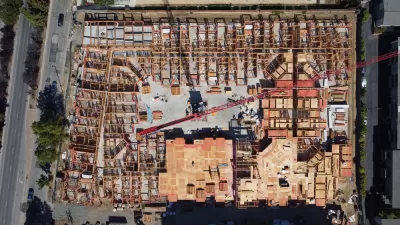Voters in the Colorado town of Boulder will consider a city charter amendment that would assign land use regulation power to 66 neighborhood-level voting districts.
Kriston Capps reports on a looming vote in Boulder, which he describes in no uncertain terms as "mega-NIMBYism at work."
In effect, the proposed charter amendment, before voters as issue #300, would give the power to change and enforce land use regulations to neighborhood-scale votes. Here's how Capps summarizes the current development approval process compared to the ballot box zoning program that would be enacted by the ordinance:
"At present, when the city council approves a zoning change, it triggers a 30-day cooling-off period during which voters can take action. If 10 percent of Boulder’s voting population sign a petition against a zoning change, then the council is required to reconsider it. The ordinance can be put up for a direct referendum. Through its elected representatives and oversight process, the city decides zoning changes for itself.
But if the proposed charter amendment passes, then the locus of the action will shift from the city to the neighborhood. The amendment serves to define 66 residential neighborhoods and invest them with petition authority. So when the council passes a zoning change that affects Chautauqua, it will only require 10 percent of the voters living in Chautauqua to successfully move a petition. And when a petition is successful and if the ordinance is put up for a vote, only voters living in Chautauqua may weigh in on the measure."
Capps also notes that another, complementary measure up for consideration in November—ballot issue #301. Development Shall Pay Its Own Way, as #301 it is also called, "would require the city to reject any new development that does not 'fully pay for or otherwise provide additional facilities and services to fully offset the additional burdens imposed by the new development.'"
Capps devotes much of the remainder of the article's word count to lambasting the consequences should voters approve the two measures. In effect, according to Capps, the city would be voting to approve a large dome to be placed over the city.
For some local commentary on the vote, Jessica Yates, a local attorney, penned an op-ed questions whether the laws would be considered constitutional under state law.
FULL STORY: 'They Are Coming for Our Neighborhoods'

Planetizen Federal Action Tracker
A weekly monitor of how Trump’s orders and actions are impacting planners and planning in America.

Congressman Proposes Bill to Rename DC Metro “Trump Train”
The Make Autorail Great Again Act would withhold federal funding to the system until the Washington Metropolitan Area Transit Authority (WMATA), rebrands as the Washington Metropolitan Authority for Greater Access (WMAGA).

DARTSpace Platform Streamlines Dallas TOD Application Process
The Dallas transit agency hopes a shorter permitting timeline will boost transit-oriented development around rail stations.

Parks: Essential Community Infrastructure — and a Smart Investment
Even during times of budget constraint, continued investment in parks is critical, as they provide proven benefits to public health, safety, climate resilience, and community well-being — particularly for under-resourced communities.

Porches, Pets, and the People We Grow Old With
Neighborhood connections and animal companions matter to aging with dignity, and how we build can support them. Here’s a human-scale proposal for aging in place.

Single-Stair Design Contest Envisions Human-Scale Buildings
Single-stair building construction is having a resurgence in the United States, where, for the last several decades, zoning codes have required more than one staircase in multi-story housing developments.
Urban Design for Planners 1: Software Tools
This six-course series explores essential urban design concepts using open source software and equips planners with the tools they need to participate fully in the urban design process.
Planning for Universal Design
Learn the tools for implementing Universal Design in planning regulations.
City of Charlotte
Municipality of Princeton
City of Camden Redevelopment Agency
City of Astoria
Transportation Research & Education Center (TREC) at Portland State University
US High Speed Rail Association
City of Camden Redevelopment Agency
Municipality of Princeton (NJ)





























